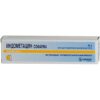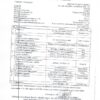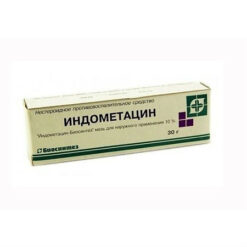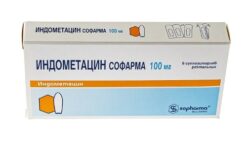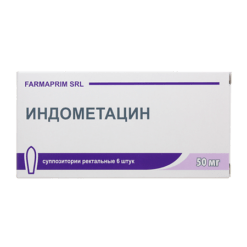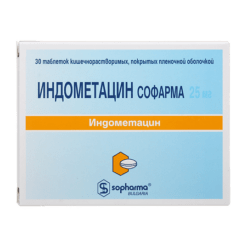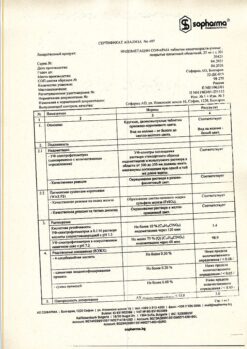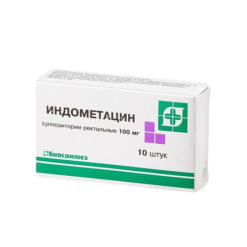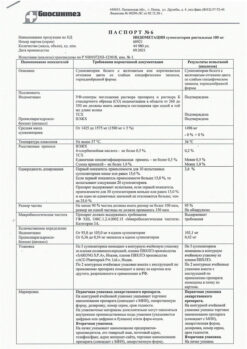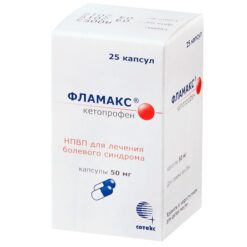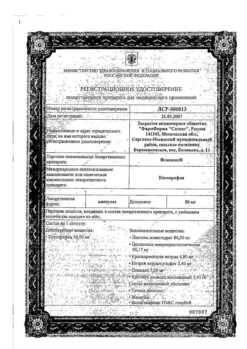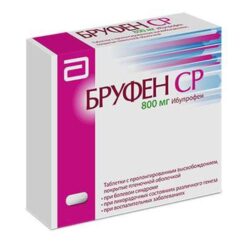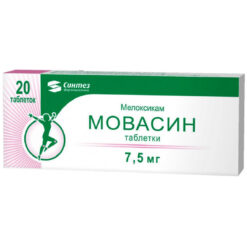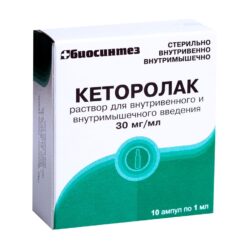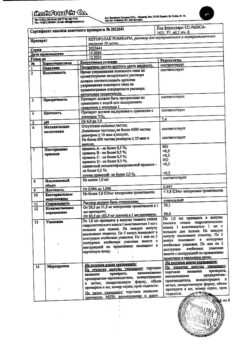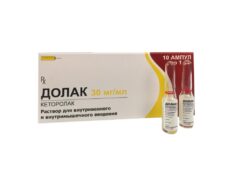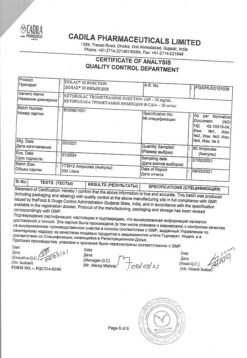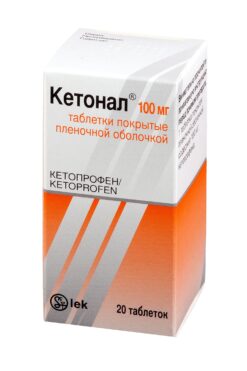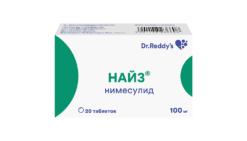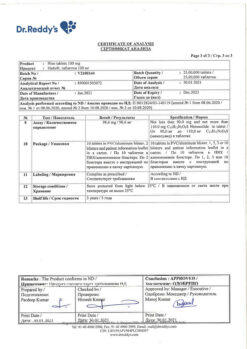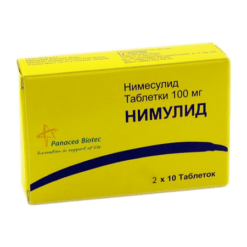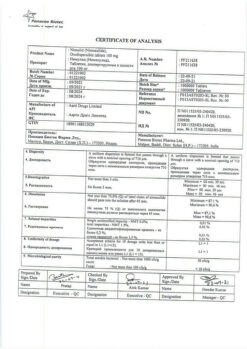No products in the cart.
Indomethacin, 10% ointment 40 g
€6.22 €5.53
Description
Indomethacin has anti-inflammatory, analgesic and antipyretic, as well as some antiaggregant action.
Inhibits the activity of anti-inflammatory factors, reduces platelet aggregation.
By inhibiting cyclooxygenase 1 and 2, disrupts arachidonic acid metabolism, reduces the amount of prostaglandins (Pg) both in the focus of inflammation and in healthy tissues, suppresses exudative and proliferative phases of inflammation.
When used topically, it causes alleviation or disappearance of pain syndrome of rheumatic and non-rheumatic character (including In case of pain of the joints at rest and when moving, it reduces morning stiffness and swelling of the joints, increases the range of motion; in case of inflammatory processes after operations and injuries, it quickly relieves spontaneous pain as well as pain while moving, reduces inflammatory swelling of the wound area).
Indications
Indications
articular syndrome (rheumatoid arthritis, osteoarthritis, ankylosing spondylitis, gout),
pain in the spine,
neuralgia,
myalgia,
traumatic inflammation of soft tissues and joints.
Pharmacological effect
Pharmacological effect
Indomethacin has anti-inflammatory, analgesic and antipyretic, as well as some antiplatelet effects.
Suppresses the activity of anti-inflammatory factors, reduces platelet aggregation.
By inhibiting cyclooxygenase 1 and 2, it disrupts the metabolism of arachidonic acid, reduces the amount of prostaglandins (Pg) both in the site of inflammation and in healthy tissues, and suppresses the exudative and proliferative phases of inflammation.
When used externally, it causes a weakening or disappearance of pain of a rheumatic and non-rheumatic nature (including pain in the joints at rest and during movement, reduces morning stiffness and swelling of the joints, helps to increase the range of movements; in inflammatory processes that occur after operations and injuries, quickly relieves both spontaneous pain and pain during movement, reduces inflammatory swelling at the wound site).
Special instructions
Special instructions
Use with caution in elderly patients, as well as with a history of liver, kidney, gastrointestinal diseases, dyspeptic symptoms at the time of use, arterial hypertension, heart failure, immediately after major surgical interventions, parkinsonism, epilepsy.
If there is a history of allergic reactions to NSAIDs, they are used only in emergency cases.
During the treatment period, systematic monitoring of liver and kidney function and peripheral blood patterns is necessary.
The ointment should be applied only to intact areas of the skin, avoid contact with the eyes or mucous membranes.
Impact on the ability to drive vehicles and operate machinery
During the treatment period, you should refrain from potentially hazardous activities associated with the need for concentration and increased speed of psychomotor reactions.
Active ingredient
Active ingredient
Indomethacin
Composition
Composition
Active ingredient:
indomethacin 10 g
Pregnancy
Pregnancy
Indomethacin is contraindicated during pregnancy, breastfeeding and children under 14 years of age.
Contraindications
Contraindications
peptic ulcer of the stomach and duodenum in the acute phase;
disorders of the blood coagulation system of unknown etiology;
hypersensitivity to the components of the drug and other NSAIDs.
Side Effects
Side Effects
From the digestive system: nausea, anorexia, vomiting, pain and discomfort in the abdomen, constipation or diarrhea, erosive and ulcerative lesions, bleeding and perforation of the gastrointestinal tract; rarely – intestinal strictures, stomatitis, gastritis, flatulence, bleeding from the sigmoid colon or from a diverticulum, jaundice, hepatitis.
From the central nervous system and peripheral nervous system: dizziness, headache, depression, feeling of fatigue; rarely – anxiety, fainting, drowsiness, convulsions, peripheral neuropathy, muscle weakness, involuntary muscle movements, sleep disorders, mental disorders (depersonalization, psychotic episodes), paresthesia, dysarthria, parkinsonism.
From the cardiovascular system: edema, increased blood pressure, tachycardia, chest pain, arrhythmia, palpitation, arterial hypotension, congestive heart failure, hematuria.
Allergic reactions: rarely – itching, urticaria, angiitis, erythema nodosum, skin rash, exfoliative dermatitis, Stevens-Johnson syndrome, erythema multiforme, toxic epidermal necrolysis, hair loss, acute respiratory distress, sharp drop in blood pressure, anaphylactic reactions, angioedema, dyspnea, bronchial asthma, edema lungs.
From the hematopoietic system: rarely – leukopenia, petechiae or ecchymosis, purpura, aplastic and hemolytic anemia, thrombocytopenia, disseminated intravascular coagulation syndrome.
From the senses: rarely – impaired clarity of visual perception, diplopia, orbital and periorbital pain, tinnitus, hearing impairment, deafness.
From the urinary system: rarely – proteinuria, nephrotic syndrome, interstitial nephritis, renal dysfunction, renal failure.
Metabolism: rarely – hyperglycemia, glucosuria, hyperkalemia.
Other: rarely – vaginal bleeding, hot flashes, increased sweating, nosebleeds, enlarged and tense breasts, gynecomastia.
Local reactions: at the site of intramuscular injection in some cases – formation of infiltrate, abscess; When used rectally, irritation of the rectal mucosa, tenesmus, and exacerbation of chronic colitis are possible.
For external use: itching, redness, rash at the site of application.
Interaction
Interaction
Indomethacin reduces the effectiveness of uricosuric drugs, antihypertensive and diuretics (saluretics).
Enhances the effect of indirect anticoagulants, antiplatelet agents, fibrinolytics, side effects of mineralocorticosteroids, estrogens, and other NSAIDs.
Enhances the hypoglycemic effect of sulfonylurea derivatives.
Combined use with paracetamol increases the risk of nephrotoxic effects.
Ethanol, colchicine, glucocorticosteroids – increase the risk of developing gastrointestinal complications accompanied by bleeding.
Increases the concentration of lithium, methotrexate, digoxin and penicillins in the blood (blockade of tubular secretion).
Cyclosporine and gold preparations increase the nephrotoxicity of indomethacin.
Cefamandole, cefoperazone, valproic acid – increase the risk of developing hypoprothrombinemia and the risk of bleeding.
Potentiates the toxic effect of zidovudine.
Overdose
Overdose
Symptoms: nausea, vomiting, severe headache, dizziness, memory impairment, disorientation. In severe cases, paresthesia, numbness of the limbs, convulsions.
Treatment: symptomatic therapy. Hemodialysis is ineffective.
Storage conditions
Storage conditions
In a dry place, protected from light, at a temperature below 25 °C.
Shelf life
Shelf life
2 years
Manufacturer
Manufacturer
Sopharma JSC, Bulgaria
Additional information
| Shelf life | 2 years |
|---|---|
| Conditions of storage | In a dry, light-protected place, at a temperature below 25 °C. |
| Manufacturer | Sofarma JSC, Bulgaria |
| Medication form | topical ointment |
| Brand | Sofarma JSC |
Other forms…
Related products
Buy Indomethacin, 10% ointment 40 g with delivery to USA, UK, Europe and over 120 other countries.



